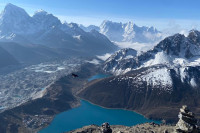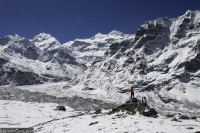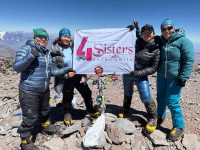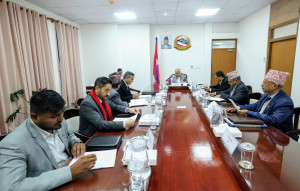Travel
Ascent to Gokyo Ri
From flying over glaciers to hearing the Himalayan Snowcock call, the trek was filled with unforgettable firsts.
Amartya Dahal
The trekking season has begun in Nepal, with climbers opting for permits. As the spring trekking season starts, I remember my trip to the Everest region two years ago when we ascended the Gokyo Ri and flew over Gokyo Lake, Ngozumpa Glacier, and Everest Base Camp II.
My friends and I had been planning a trip after our final year exams. A few years ago, we had travelled to Poon Hill and Mardi Himal Base Camp, and now, nearly the same group of five was set to embark on a journey to Gokyo Ri.
After finishing my exam, I went to my hometown, Biratnagar. Once our plans were set, I searched for a flight to Lukla, but unfortunately, no direct flights were available from Biratnagar. This lack of direct air service reveals an oversight in Nepal’s aviation strategy and represents a lost opportunity to enhance connectivity between important regions. Consequently, I had to fly to Kathmandu before heading to Lukla.
Lukla has always been considered one of the most dangerous airports in the world, if not the most dangerous. But to our surprise, the flight and landing were smooth, even smoother than some regular domestic flights between the big cities.
As we arrived, we were greeted by the stunning Kongde Ri. However, my knee ached while walking—a lingering soreness from my trip to Thulo Pathibhara two days earlier. Despite the discomfort, I pressed on. After enjoying breakfast in Lukla, we set off on our journey. Following a brief trek to Phakding, we took a break for lunch. We explored the area and relished the tranquil views of the Dudh Koshi river. Our first overnight destination was Monjoo.
On the second day, the climb to Namche Bazaar was quite steep. Although the trek was exhausting, the beauty of the Bazaar energised us. Namche is a hill city with houses built in steps, similar to terrace farming. We were welcomed by water powered maneys. We reached our hotel and were warmly welcomed by our family friend.
The third day was acclimatisation day. The night before, we had a proper rest and started our journey to the Everest View Hotel. It was a wonderful place with a panoramic view of the mountains. Everest, Lhotse, and Nuptse were like three siblings who couldn’t be separated. Mt Ama Dablam, meaning “mother’s necklace,” was beautiful like any jewellery.

On our way back, we took a different route and learned about Khumjung village. While descending to the village, the knee pain was so severe that I couldn’t flex or extend my knee. I had to rest for a while and slowly descended with my friends. A highlight of our trek was at Sagarmatha Next, where we experienced a 3d journey to the Balcony Camp of Mt Everest using virtual reality headsets.
On the fourth day, we began our journey a bit late, accompanied by our family friend and their team. Along the way, we discovered that the Everest View Hotel was established by a Japanese and opened to the public in 1971 AD. We parted ways with our family friend’s team in Kyamjung.
On the fifth day, we took a short trek to avoid mountain sickness. The route was mostly stony with sparse vegetation. We crossed Lapharma and noticed many rocky caves along the way. We crossed through Lapharma and Lazu, encountering a number of yaks. Arriving in Machermo quite early, we spent some time playing cards together. At around 5 pm, the weather cleared, revealing views of the hills—Thamserku to the east, and Lazu and Machermo to the west.
On the sixth day, we started our journey a little early. The weather was clear in the morning. We were surrounded by snow-capped mountains and blessed with the sound of the Himalayan Snowcock. We were reunited with Dudhkoshi in Phangma, which we left earlier around Namche Bazaar. Then, it was all about walking towards the origin of Dudh Koshi.
Arriving at Gokyo Lake 1, we were mesmerised. Excited, we ran towards the lake, clicked many photos, and proceeded forward. After crossing Gokyo Lake 2, we reached Gokyo Lake 3, our destination and accommodation for the night. It was beautiful, with the Himalayas in the background. Gokyo lakes are the highest freshwater lake system in the world.

There are many things to do at Gokyo Lake 3: visit the fifth lake, climb Gokyo Ri, or tackle the three passes to reach Everest Base Camp. We intended to ascend Gokyo Ri, which stands at 5357 metres, to enjoy views of Cho Oyu and a unique perspective of Everest, along with Lhotse and Nuptse.
We scheduled our climb for the evening because we anticipated a golden sunset over Mt Everest. Unfortunately, the weather atop Gokyo Ri was not favourable, shrouded in clouds, so we postponed our ascent.
The following morning, we began our trek around 4 am. The climb was quite steep, and we relied on our headlamps to guide us. We soon caught up with a foreign group, accompanied by a Nepali guide. When we finally reached the summit of Gokyo Ri, we jumped with joy; the effort we had put in over the previous days was well worth it for the breathtaking view from the top.
The outline of Mt Everest and several other peaks were visible, but the most stunning sight was the broad-based “Turquoise Goddess,” Mt Cho Oyu.
A friend and I took a helicopter back to Lukla the following day. As we ascended, we caught our last glimpse of the Gokyo lakes. Flying near the snow-capped hills created a memory we will cherish forever. We soared over the Ngozumpa Glacier, which is considered the longest glacier in the Himalayas. It was incredible to fly above the second camp of Mt Everest.
When we arrived in Lukla, the weather was poor, forcing us to remain there until we could catch a flight the following day. Weather conditions can pose challenges for travellers heading to Lukla. The next day, we flew back to Kathmandu.
We used the refreshment to energise us for the challenging internship journey ahead. There were many firsts: a view of the peaceful and aptly named Dudh Koshi, spotting a Danphe, hearing the impressive call of the Himalayan Snowcock, and climbing a five-thousand-metre mountain.




 12.12°C Kathmandu
12.12°C Kathmandu










